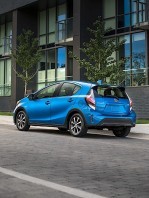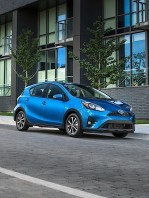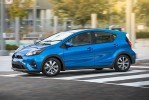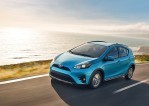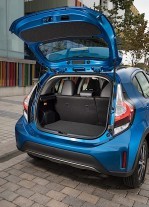Body style: Hatchback
Segment: Compact
Production years: 2017, 2018, 2019, 2020, 2021
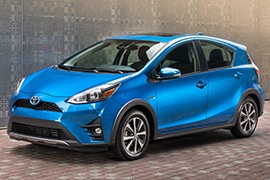 20 Photos
20 PhotosToyota introduced the Prius C in 2011 as a more affordable, practical, and funky version of the well-known Prius, and by 2017 it already received a second facelift, in addition to the one introduced in 2014.
Since the Prius was already a worldwide phenomenon, Toyota considered expanding its hybrid range. So, besides the liftback version, it also launched the Prius C (from Compact) and the Prius V (V stood for Versatile) minivan. All these helped the Japanese automaker make more money from the same platform, which was a good thing since it increased the sums spent on research and the development of new products. Toyota had already led the hybrid-car industry segment and tried to keep it that way. The Prius C targeted young customers who were willing to spend less on fuel and still be able to drive a fancy-looking car. Even though it wasn’t such a statement vehicle, like the regular Prius, some might say that it was the next best thing. In a way, since it was more affordable, it really was. On the other hand, the price was reflected in many areas, especially inside the cabin. With the 2018 model year, Toyota tried to improve its compact-sized hatchback based on the Prius platform to make its customers happier.
The car’s exterior was slightly updated, and at the front, the automaker installed a new bumper that sported a more aggressive styling. Furthermore, the headlights’ shape resembled those placed on the sporty Toyota GT86, which made its young customers feel happy, even though the Prius C was on the wrong side of the near-ten-second acceleration time from 0 to 60 mph (0-97 kph). Depending on the grade, the car could be optioned with round fog lamps installed in the side scoops that flanked the apron.
From its profile, there were just a few tiny updates for the 2018 Prius C. But still, a keen eye for detail could notice the turn signal lamps integrated into the door mirrors. On the other hand, the 15-inch steel wheels with plastic caps were still part of the basic package. Toyota also suggested that the car could win the hearts and wallets of young customers by offering the Prius C with a roof spoiler mounted atop the rear tailgate and a set of high-mounted taillights that flanked the rear window. Above the license plate, in the back, Toyota added a standard reversing camera for most of the car’s trim levels.
Inside, the Prius C came with more updates than the exterior. Toyota improved the standard features on most grades, and the car came fitted with an improved touchscreen for the Entune infotainment system, which offered a higher resolution. In addition, the rear camera also displayed guiding lines, which eased parking in tight spots. Atop the dashboard, closer to the windshield, the automaker installed the multi-function display that served as an instrument panel. It also featured a new 3.5-inch color screen in the middle, which showed data for the hybrid system. It could be controlled via a few buttons mounted on the steering wheel. Moving on the passenger side, customers could find two plugs, one for a USB and another for a 3.5-mm jack for audio input, integrated into a small shelf that could host an MP3 player, an iPod, or a mobile phone. Bluetooth connectivity was standard across the range, helping the one behind the wheel stay focused on the road while taking or making calls. In addition, to help them navigate, the automaker installed a lane-keep assist system. Out back, the 60/40 split-folding bench seat was available from the second grade, named the Two, expanding the trunk.
There were no significant technological changes under the car’s skin. The same 1.5-liter Atkinson-cycle engine powered the entire hybrid system, which took its energy from a battery pack installed under the rear seats.
TOYOTA Prius c 2017, 2018, 2019, 2020, 2021
- 1.5 CVT (99 HP)
TOYOTA Prius c
1.5 CVT (99 HP)
ENGINE SPECS - 1.5 CVT (99 HP) | |
|---|---|
| Cylinders: | L4 |
| Displacement: | 1497 cm3 |
| Power: | 54.4 KW @ 4800 RPM 74 HP @ 4800 RPM 73 BHP @ 4800 RPM |
| Torque: | 61 lb-ft @ 4000 RPM 82 Nm @ 4000 RPM |
| Fuel System: | Multipoint Injection, Atkinson Cycle |
| Fuel: | Hybrid |
PERFORMANCE SPECS | |
|---|---|
| Top Speed: | 106 mph (171 km/h) |
| Acceleration 0-62 Mph (0-100 kph): | 11.5 s |
TRANSMISSION SPECS | |
|---|---|
| Drive Type: | Front Wheel Drive |
| Gearbox: | eCVT |
BRAKES SPECS | |
|---|---|
| Front: | Ventilated Discs |
| Rear: | Discs |
TIRES SPECS | |
|---|---|
| Tire Size: | P175/65R15 |
DIMENSIONS | |
|---|---|
| Length: | 162.4 in (4125 mm) |
| Width: | 68.6 in (1742 mm) |
| Height: | 59.6 in (1514 mm) |
| Front/rear Track: | 58.3/58.1 in (1,481/1,476 mm) |
| Wheelbase: | 100.4 in (2550 mm) |
| Ground Clearance: | 5.5 in (140 mm) |
| Cargo Volume: | 17.1 cuFT (484 L) |
| Aerodynamics (Cd): | 0.28 |
WEIGHT SPECS | |
|---|---|
| Unladen Weight: | 2531 lbs (1148 kg) |
| Gross Weight Limit: | 3338 lbs (1514 kg) |
FUEL ECONOMY (NEDC) | |
|---|---|
| City: | 48 mpg US (4.9 L/100Km) |
| Highway: | 43 mpg US (5.5 L/100Km) |
| Combined: | 46 mpg US (5.1 L/100Km) |
| Notes |
|---|
| Hybrid system Electric motor power: 45 kW (61 HP) Electric motor torque: 169 Nm (125 lb-ft) Total system power: 74 kW (99 BHP/100 HP) |

